| Igneous
Rocks - Dolerite
Dolerite
is the medium grained, intrusive, equivalent of a basalt (link to basalts).
It usually occurs as dykes, plugs or sills. Being intruded into country
rocks at shallow levels, the magma has more time to cool than if extruded.
This allows for the growth of constituent minerals to the point where
the groundmass crystals may be easily identified with a hand lens if not
the naked eye. Dolerites may be porphyritic, containing phenocrysts of
plagioclase, olivine and even quartz (an olivine analcite dolerite is
known as a crinanite).
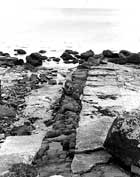  On
Arran, dolerite forms the majority of the sills and dykes seen. Tertiary
igneous activity saw the stretching of the crust as the North Atlantic
was opening. Weaknesses in the crust became exploited by magmas which
solidified to create the dykes and sills. Dyke swarms, chiefly doleritic,
can be seen all along the south coast of Arran and are especially well
exposed at Kildonan and Largybeg. On
Arran, dolerite forms the majority of the sills and dykes seen. Tertiary
igneous activity saw the stretching of the crust as the North Atlantic
was opening. Weaknesses in the crust became exploited by magmas which
solidified to create the dykes and sills. Dyke swarms, chiefly doleritic,
can be seen all along the south coast of Arran and are especially well
exposed at Kildonan and Largybeg.
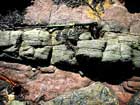 These
hypabyssal rocks intrude Permian and Triassic sediments. when this happens
there is often local alteration, confirming that the host rock was formed
first and that the dyke intruded later. On Arran, look carefully at the
margins of the dykes, and you will see that in some case there is a prominent
'chilled margin', where the hot intruding lava has cooled more quickly
where it was in contact with the cool host rock. The centres of such dykes
will be more coarsely crystalline as they cooled much more slowly and
crystal had longer times to grow. You can see this with the naked eye,
and even more clearly with a geological hand-lens. These
hypabyssal rocks intrude Permian and Triassic sediments. when this happens
there is often local alteration, confirming that the host rock was formed
first and that the dyke intruded later. On Arran, look carefully at the
margins of the dykes, and you will see that in some case there is a prominent
'chilled margin', where the hot intruding lava has cooled more quickly
where it was in contact with the cool host rock. The centres of such dykes
will be more coarsely crystalline as they cooled much more slowly and
crystal had longer times to grow. You can see this with the naked eye,
and even more clearly with a geological hand-lens.
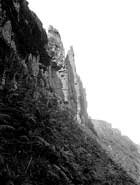 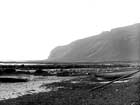 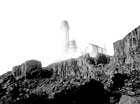  Famous
examples of dolerite intrusions on Arran include: Dippin
Head Sill, an olivine dolerite; Padda
sill, a quartz dolerite sill on an island off the south coast of Arran;
and Levencorroch sill, also a quartz
dolerite. Bennan Head is another
good locality to see the evidence of the importance of volcanic intrusions
on Arran. Famous
examples of dolerite intrusions on Arran include: Dippin
Head Sill, an olivine dolerite; Padda
sill, a quartz dolerite sill on an island off the south coast of Arran;
and Levencorroch sill, also a quartz
dolerite. Bennan Head is another
good locality to see the evidence of the importance of volcanic intrusions
on Arran.
|

